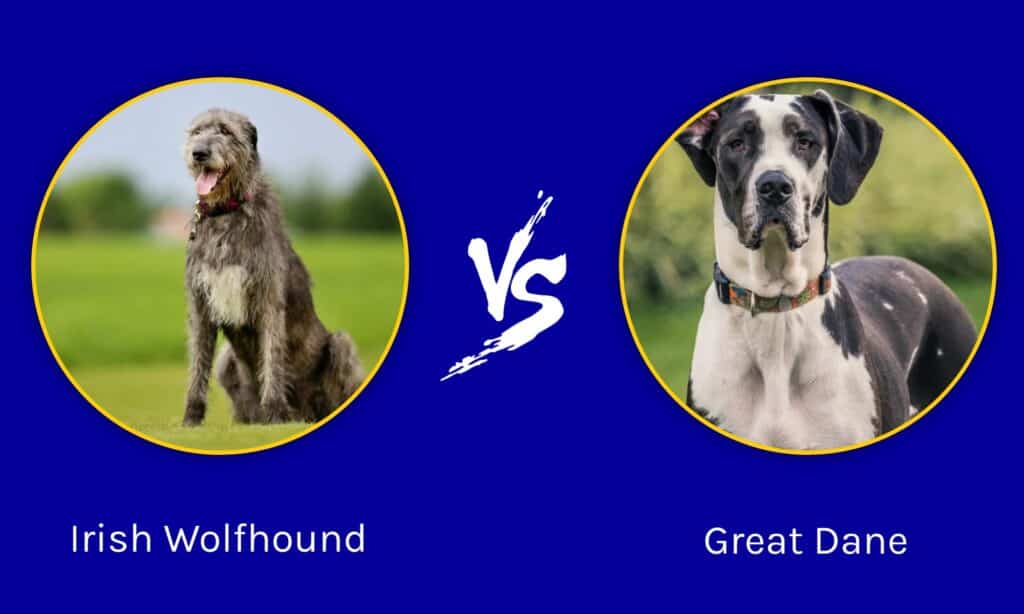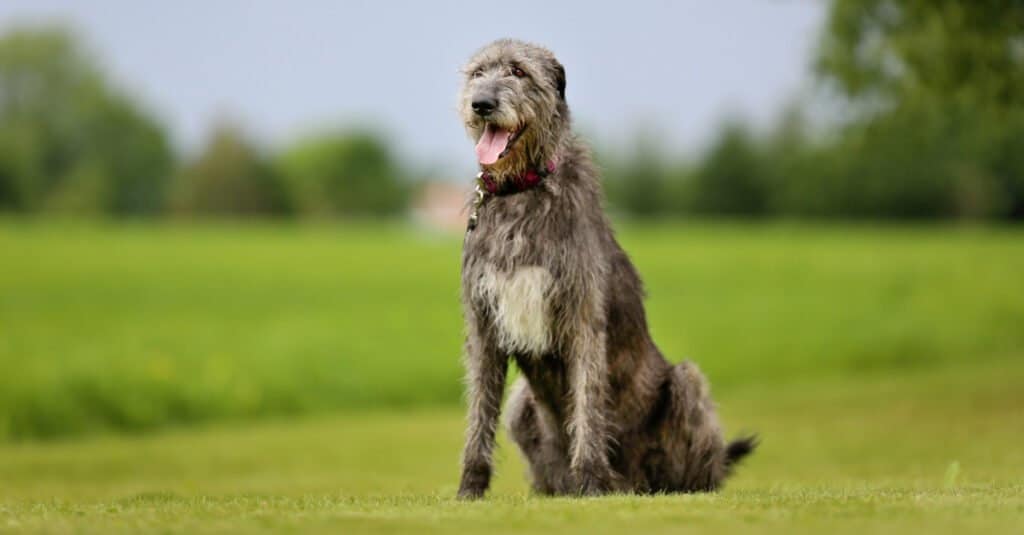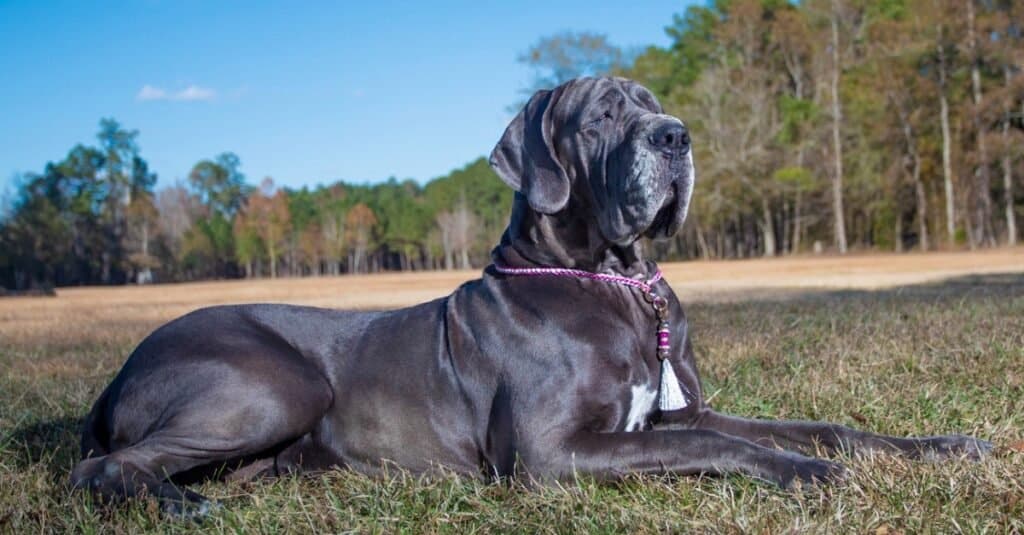Both the Irish Wolfhound and the Great Dane are giant dogs. Although they have quite a few things in common, they are very different. Both breeds require minimal grooming and can live indoors comfortably. In this article, we’ll discuss eight key differences between the Irish Wolfhound and the Great Dane in terms of appearance, characteristics, and health.
Irish Wolfhound vs Great Dane: A Comparison

| Irish Wolfhound | Great Dane | |
|---|---|---|
| Height | 28 – 35 inches | 28 – 32 inches |
| Weight | 90 to 160 lbs. | 110 to 175 lbs. |
| Coat type | Coarse, Strong, Long, Wiry | Short, Dense, Smooth |
| Color | Gray, Brindle, Red, Black, White. Fawn | Fawn, Blue, Brindle, Merle, Black, Harlequinn, Mantle |
| Temperament | Loyal, Reserved, Smart, Sweet | Gentle, Excitable, Intelligent, Loving |
| Trainability | Somewhat Difficult | Above Average |
| Life Expectancy | 6 to 10 Years | 8 to 10 Years |
| Health Problems | Cardiomyopathy, PRA, Stomach Torsion | Cardiomyopathy, Hip Dysplasia |
Key Differences Between Irish Wolfhound And Great Dane

The Irish Wolfhound differs from the Great Dane in size, appearance, and lifespan.
©iStock.com/Bigandt_Photography
The key differences between the Irish Wolfhound and the Great Dane are appearance, size, health risk, and temperament. The term “big” as related to size is typically defined in height or weight, with each dog proving triumphant. Great Danes are frequently larger dogs, although Irish wolfhounds generally are taller. Their similar size is most likely owing to shared DNA.
Although the Irish Wolfhound originated in Ireland and the Great Dane originated in Germany, most experts say that the Great Dane’s genealogy is a cross between the English Mastiff and the Irish Wolfhound. Let us delve more into the appearance, personality, and health of both breeds.
Irish Wolfhound vs Great Dane: Height
The Irish Wolfhound stands between 28 and 35 inches tall, whereas the Great Dane stands between 28 and 32 inches tall.
Irish Wolfhound vs Great Dane: Weight
Great Danes weigh between 110 and 175 pounds depending on the type, whereas the Irish Wolfhound weighs between 90 and 160 pounds on average.
Irish Wolfhound vs Great Dane: Coat Type
The Irish Wolfhound’s coat is coarse and strong. Around the eyes and beneath the jaw, wiry and long hair grows.
Great Danes have a single smooth and short coat. The coat requires little upkeep and is simple to groom. Their coat is shorter than Irish Wolfhounds. An Irish Wolfhound’s fur is longer and shaggy.
Irish Wolfhound vs Great Dane: Color
Black, brindle, fawn, blue, merle, harlequin, and mantle are the major seven AKC-approved colors. While some individuals consider white and “fawnaquin” to be color patterns, these are not considered by the purest breeders and fans. The Irish Wolfhound’s coat colors are gray, brindle, red, black, white, or fawn.
Irish Wolfhound vs Great Dane: Temperament

Despite their daunting size, Danes are highly affectionate and social.
©iStock.com/gsagi
Both Great Danes and Irish Wolfhounds have distinct personalities, yet both make excellent family dogs. For example, Great Danes are gentler and more relaxed. They are renowned for their affection and quirkiness and generally get along with other animals, especially if they have been raised with them. Certain members of the breed might be antagonistic toward unfamiliar canines.
Irish Wolfhounds are surprisingly calm, loyal, sweet, and loving dogs. However, their size and stride may cause them to knock over anything, especially tiny children. As a result, they’re ideal for households with older children.
Irish Wolfhound vs Great Dane: Trainability
Great Danes are bright and highly trainable when their instruction is consistent and rewarding. Irish Wolfhounds are notoriously tough to teach since they have an independent streak and want to do things their way. As a result, these canines will be difficult for inexperienced dog owners to handle.
However, they are intelligent and trainable when trained consistently and positive reinforcement techniques such as food rewards and praise is used.
Irish Wolfhound vs Great Dane: Life Expectancy

The Irish Wolfhound has a lifespan of 6-10 years.
©Viktoriia Bondarenko/Shutterstock.com
Because the Irish Wolfhound’s bodies are so large, organs like the heart must work significantly harder, shortening their longevity to 6 to 10 years. For such enormous canines, Great Danes get the short end of the stick when it comes to longevity. The typical lifespan of a Great Dane is 8-10 years.
Irish Wolfhound vs Great Dane: Health Problems
Irish Wolfhounds are susceptible to hip and elbow dysplasia, cardiomyopathy, osteosarcoma, hepatic shunt, autoimmune thyroiditis, von Willebrand’s disease, progressive retinal atrophy, and stomach torsion. Some of these ailments are incurable, while others manifest themselves later in life.
Bloating, Cardiomyopathy (heart disease), Hip Dysplasia, Wobbler syndrome (a serious neck vertebral disorder), Osteosarcoma (bone cancer), Allergies (skin irritation), Cataracts, and benign skin growths are all prevalent concerns for Great Danes.
Which is Bigger Mastiff or Wolfhound?
The Irish Wolfhound and English Mastiff hold remarkable records in the world of canines and dog breeds in general. The Irish Wolfhound stands as the world’s tallest dog breed, with a history dating back to 391 A.D.
On the other hand, the English Mastiff, which is an even older dog breed that dates back to 55 B.C., was also famously admired by Julius Caesar during his Roman invasion of the British Isles. These two breeds, while both absolutely huge, differ greatly in coloring and general appearance.
The only real common trait of these two breeds is their partially large size, but they exhibit their oddities in pretty distinctive ways. While the Great Dane currently holds the official title of the tallest dog globally, the Irish Wolfhound typically ranks as the tallest breed.
Wrapping up Irish Wolfhound vs Great Dane
There are numerous similarities between dogs from these two giant dog breeds, yet each one is distinctive in its way. Regardless, your family will benefit from having a gentle giant as a guardian and companion, no matter which of the two breeds you choose.
The photo featured at the top of this post is © iStock.com/Ashva
Ready to discover the top 10 cutest dog breeds in the entire world?
How about the fastest dogs, the largest dogs and those that are -- quite frankly -- just the kindest dogs on the planet? Each day, AZ Animals sends out lists just like this to our thousands of email subscribers. And the best part? It's FREE. Join today by entering your email below.
Thank you for reading! Have some feedback for us? Contact the AZ Animals editorial team.






